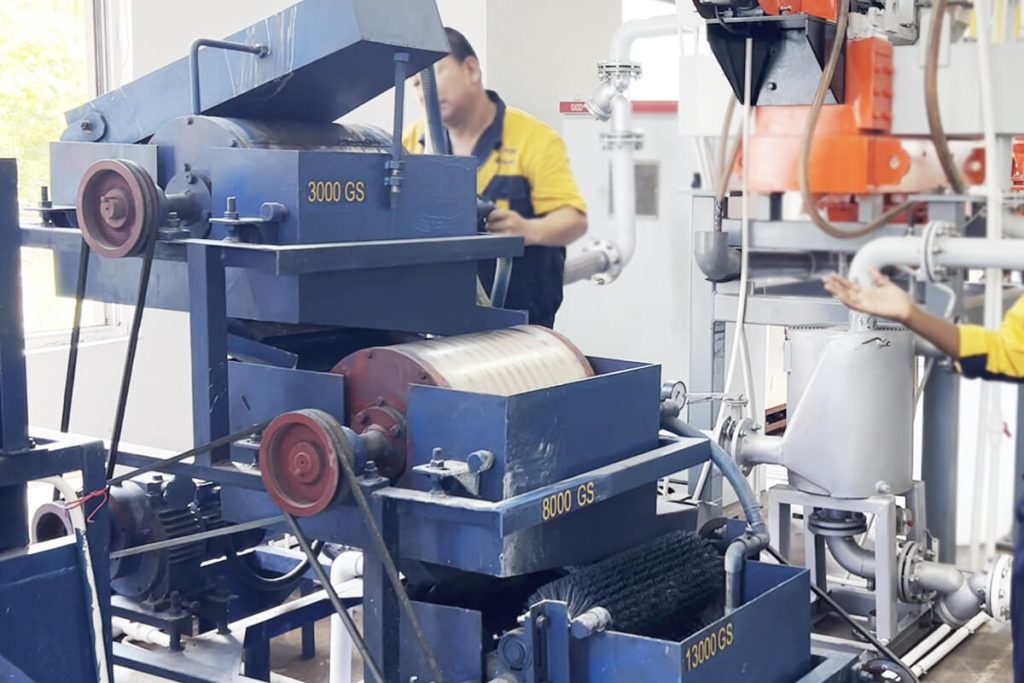Hematite is a weakly magnetic mineral with a specific magnetic susceptibility ranging from 3.8×10-5m³/kg to 1.26×10-7m³/kg. Its magnetic characteristic is that the relationship between the magnetization intensity and the external magnetic field intensity is a straight line, without the hysteresis or magnetic saturation phenomenon that vital magnetic minerals have.
Hematite magnetic separation testing is critical in the mining and mineral processing industry. The test involves using a magnetic separator to separate and concentrate hematite particles from other impurities. The goal is to efficiently recover hematite, a valuable iron ore mineral, while removing unwanted elements such as silica, alumina, and phosphorus. By optimizing this process, mining companies can increase productivity and profitability while maintaining environmental sustainability.
Importance of Hematite Magnetic Separation Testing
Laboratory hematite magnetic separation testing is vital in the mineral processing industry. It enables researchers and engineers to determine the efficiency of magnetic separation technology in extracting hematite from complex ore bodies. By conducting these tests in a controlled laboratory environment, professionals can fine-tune their methods and optimize hematite recovery, ensuring a high-quality end product with minimal waste.
Furthermore, the results of such tests provide valuable insights into the behavior of hematite during magnetic separation. This data helps develop innovative technologies and improve existing methods, ultimately helping to make large-scale industrial operations more efficient and cost-effective. Additionally, by understanding how different variables affect magnetic separation performance, researchers can experiment with various parameters to achieve superior results and thus successfully bring large-scale mineral processing lines into production.
Hematite magnetic separation equipment
A key consideration in hematite magnetic separation testing is selecting the correct type of magnetic separator. Different types of separators, such as drum separators, roller separators, or high-strength magnetic separators, offer specific advantages regarding particle size range and capacity. Furthermore, magnetic field strength and gradient are essential in achieving efficient separation results. Understanding these nuances is critical to designing effective separation strategies that maximize hematite recovery while minimizing operating costs.
Because of the weak magnetic properties of hematite, we usually use high-intensity magnetic separators for separation.
- The barrel is made of new corrosion-resistant, wear-resistant, and non-magnetic minerals, which significantly improves its ability to withstand minerals;
- Trough structure with high resistivity, wear resistance, and corrosion resistance;
- The strong magnetic separator can adjust the thickness of the ore layer, magnetic field strength, working gap, cylinder speed, and amplitude and frequency of the vibration tank according to the properties and concentration of the selected materials.

Hematite magnetic separation Testing
The hematite magnetic separation test is critical in extracting valuable iron ore in mineral processing. In addition to the complex technology, successful magnetic separation of hematite can bring economic benefits and environmental advantages by providing a sustainable source of iron ore.
Step 1: Sample Preparation
Before conducting hematite magnetic separation testing, it is critical to prepare the sample correctly. It involves crushing and grinding raw materials to a specific particle size and thoroughly mixing all ingredients. Proper sample preparation is essential to obtaining accurate and reliable results in magnetic separation testing.
Step 2: Magnetic separation test
The next step involves the actual magnetic separation testing process. This typically involves applying a magnetic field to a prepared sample and observing the separation of hematite from other materials. Different methods, such as wet or dry magnetic separation, can be used, each with advantages and limitations. It is critical to carefully record test conditions and results for future analysis and comparison. After the ore is prepared, it is usually magnetically separated using a high-intensity magnetic separator to extract the hematite concentrate effectively.
Step Three: Analysis and Interpretation
After completing the magnetic separation test, the results must be analyzed thoroughly. This includes determining the efficiency of hematite extraction, assessing any impurities in the separated fractions, and evaluating potential losses or inefficiencies in the process. Interpreting these findings will provide valuable insights into optimizing hematite magnetic separation processes for industrial applications.
The key to optimizing this testing process is understanding the interaction of various factors such as feed particle size, magnetic field strength, and process parameters. By fine-tuning these variables, engineers work to achieve maximum hematite recovery while minimizing impurities. In addition, advances in magnetic separator design and technology have opened up new possibilities for increasing efficiency and reducing energy consumption during testing.
Asia-Africa International‘s technology provides a guarantee for hematite magnetic separation testing services. Integrating automation and sensor-based sorting systems can achieve real-time monitoring and control of the separation process. Magnetic separation not only improves efficiency but also ensures stable quality of the final hematite concentrate product. In addition, the high-quality equipment we provide further enhances the performance and sustainability of mineral processing operations.
